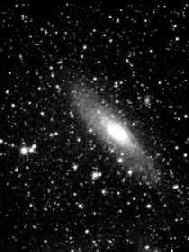 M31, 580x772 jpeg, 40k , M31, 290x386 jpeg, 17k
M31, 580x772 jpeg, 40k , M31, 290x386 jpeg, 17k
Location: Bonn, Germany
 M31, 580x772 jpeg, 40k , M31, 290x386 jpeg, 17k
M31, 580x772 jpeg, 40k , M31, 290x386 jpeg, 17k
On October 22, I tried to image M31 with a telephoto lens (Nikon f=105mm/2.5) from my home site. Tracking was done by my G11-mount. I used exposure times from 80 and 120 seconds at the low and high resolution modes of the camera. Series of nine images with and without deep-sky filter were made. After dark subtraction, gain-normalization and registration the images were median-combined and flat-fielded. The best results are presented here. The second image as the following are log-scaled and gives you a more natural view, just as if you were observing visually through a medium sized telescope. As you can see it was quite cold outside that night.
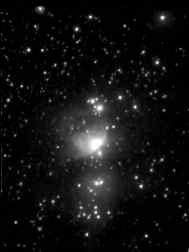 M42 and Orion's sword, 580x772 jpeg, 37k
M42 and Orion's sword, 580x772 jpeg, 37k
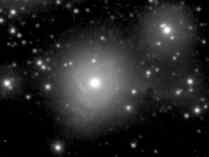 Horsehead nebula, detail, jpeg, 20k
Horsehead nebula, detail, jpeg, 20k
First examples of deep-sky objects, taken with my CG11-telescope and the LcCCD14.
Open cluster in Perseus. Together with NGC884 it forms the famous double cluster which is a deep-sky object for the naked eye. It is one of the youngest clusters known, consisting of many super luminous O-type stars, it is located in the next spiral arm of our galaxy, the Perseus arm. I use it often for focusing my camera. This and all the following images were made with the help of the focal reducer, which reduces the focal length of the telescope to 70 inches, the resulting f-stop is 1:6.3.
M1, the Crab Nebula, a relic of the supernova from 1054. The small star at 4 o'clock is the most energetic pulsar known. As pulsars age, their rapid rotation slows. This gradual slowdown powers all kinds of emissions. Astronomers define the spin-down luminosity of a pulsar as the rate at which the star loses its kinetic energy of rotation. By this measure the most energetic pulsar is the one above. Spinning once every 0.033 second, the Crab pulsar is loosing 100000 times more energy than the sun radiates!
18 images of one minute exp. time were processed for this one.
27 images of one minute exp. time were processed for this one. The bad signal to noise ratio does not allow to bring out more from the faint spiral arms and the prominent dust clouds. Next time I will do it better.
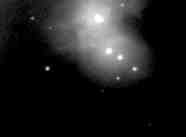 Trapezium,
the core of M42, jpeg, 4k
Trapezium,
the core of M42, jpeg, 4k
9 images of 15 seconds were used.
Three globular clusters! can be identified in this image: G185 at pixel 255,204, G189 at 179,179 and G177 at pixel 304,194. Ref.: Hodge's Atlas of the Andromeda Galaxy
I was able to observe three others visually, G76, G78 and G280 when I stayed in the Austrian Alps last autumn.
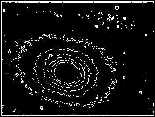 Isophotes of images above, jpeg, 17k
Isophotes of images above, jpeg, 17k
We know that the great Andromeda galaxy has a double nucleus since the HST has imaged it in 1993. Since the two peaks have an apparent distance of less than 0.5" it is nearly impossible to resolve it with ground-based telescopes.
NGC404 is a small 13mag elliptical galaxy next to Beta-Andromeda. The apparent distance is 6' to the south-east. The huge contrast between the two is managed by the ccd thanks to anti-blooming, which is not always as useful in ccd-imaging of deep-sky objects, because it reduces sensitivity by 30%. The exposure of the first image was 33 seconds for the second I used one minute. Both are single shots where just the obscurity signal was subtracted. These images are my first extragalactic objects after the core of M31 which I obtained in the same night, August 10th, 1997.
The next night I tried M57, the famous ring nebula in Lyra. It was really disappointing, because I could not detect anything with 22 seconds exp. time. I tried it with 1 minute and there it was ...
the faint glow of real, warm electrons, originated in the swinging crystal of my ccd in a hot summer night. I was pleased that it was possible to detect such an elusive thing in the shimmering heavens over Bonn. Really!?? Yes it was a small step for mankind, but ...
I was not so successful in the night from 12th to 13th of August. The only resultis this image of M77 also known as NGC1068 or Arp 37.
This 9.6mag object belongs to a special class of galaxies, known as Seyfert galaxies. They have unusual bright, almost stellar-like cores. Their spectra reveal brought emission lines, indicating outflowing gas at speeds of several 100km/sec from the central regions, which are also starburst regions. Some authors distinguish between Seyfert galaxies of type I and II according to the broadening of the emission lines, but that might be a projection effect, depending on the angle of view. It is expected, that the powering machine is a huge black hole of millions of solar masses. Seyfert galaxies are thought to be intermediate between normal galaxies and quasars according to their violent nuclear activity. They are also interesting variable radio objects,( here Cetus A), and they are prominent in the infrared and in x-ray, too. Variability is also observed at all wavelength, indicating a compact object. The central spiral features here are only 20"x50" small and over-exposed in most cases. On deeper images, faint large spiralarms can be traced out. Other famous Seyfert-Galaxies are M82, NGC5128 and NGC4151 As not only the central region shows an disrupted appearance, this galaxy has also become a member of Arps Atlas of Peculiar Galaxies.
More images of deep sky objects and a supernova, can be found on the next page, were I describe my new CCD camera.
Retrieve an image from any region of the sky with the help of the Digital Sky Survey .
Or search NASA's extragalactic databases NED for
images .
Comments welcome, contact:
